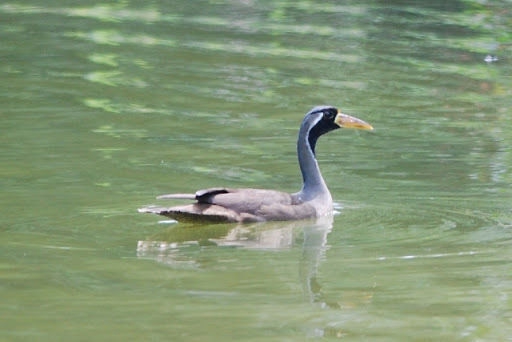| Citation |
|
Description |
Geographic Range [top]
Range Description: Heliopais personatus is patchily distributed from north-east India and Bangladesh, through Myanmar, Thailand, Cambodia, Laos and Vietnam to Peninsular Malaysia, Sumatra and Java (one record), Indonesia (BirdLife International 2001). Populations are apparently in steep decline throughout its range such that its population is now thought to number in the low thousands at most, and possibly fewer than 1,000 mature individuals (J. C. Eames in litt. 2007). The lastest record from Sumatra dates from 2009, the first sighting in Indonesia for 16 years (M. Iqbal in litt. 2016). Elsewhere it continues to be recorded from the Sundarbans of Bangladesh (Mansur in litt. 2005) and it was recently recorded in Bharatpur district, India (Verma and Mathur 2006); there are recent records from Cambodia (Goes et al. in prep.), Thailand and Peninsular Malaysia. Kachin state, Myanmar is the least known part of its range; the area probably supports the largest remaining population and it was recorded as still relatively common during wetland surveys in the early 2000s (J. C. Eames in litt. 2007). Its movements are poorly known; it appears to occur as a migrant in parts of the range, but breeding has been reported recently from Cambodia, Myanmar and Bangladesh (Neumann-Denzau 2008), and birds are recorded in most seasons in the Sundarbans and Myanmar. No empirical estimates exist for the current rate of decline, but as a species reliant on undisturbed wetlands declines are anticipated across its range given the pressure on riverine and mangrove habitats. Threats in Myanmar (now assumed to be the speciess stronghold) remain largely unknown, but several major river systems that have until now remained in a largely natural state, are now threatened by dam development and heavy immigration (W. Duckworth in litt. 2008).
Countries occurrence:
Native:
Bangladesh; Cambodia; India; Indonesia; Lao Peoples Democratic Republic; Malaysia; Myanmar; Singapore; Thailand; Viet Nam
Additional data:
? Continuing decline in area of occupancy (AOO): Yes
? Extreme fluctuations in area of occupancy (AOO): No ? Estimated extent of occurrence (EOO) - km2: 1810000
? Continuing decline in extent of occurrence (EOO): Yes ? Extreme fluctuations in extent of occurrence (EOO): No
? Number of Locations: 11-100 ? Continuing decline in number of locations: Unknown
? Extreme fluctuations in the number of locations: No
? Upper elevation limit (metres): 1220
Range Map: Click here to open the map viewer and explore range.
Population [top]
Population: The species appears to have declined dramatically and is now known from comparatively few sites, occurring at low densities everywhere. The population may now number as low as 1,000 individuals (J. C. Eames in litt. 2007), and so is placed in the band 1,000-2,499 individuals. This equates to 667-1,666 mature individuals, rounded here to 600-1,700 mature individuals.
Trend Justification: Very rapid declines are suspected over the past three generations in this long-lived species. Habitat conversion has been a major threat over the period with riverine systems amongst the most disturbed and most degraded environments in South-East Asia.
Current Population Trend: Decreasing
Additional data:
? Number of mature individuals: 600-1700 ? Continuing decline of mature individuals: Yes
? Extreme fluctuations: No ? Population severely fragmented: No
? No. of subpopulations: 2-100 ? Continuing decline in subpopulations: Unknown
? Extreme fluctuations in subpopulations: No ? All individuals in one subpopulation: No
? No. of individuals in largest subpopulation: 1-89
Habitat and Ecology [top]
Habitat and Ecology: It occurs principally in rivers in lowland riverine forest including mangroves, but has been recorded in coastal and inland wetlands, such as tidal creeks, flooded forest, swamps and lakes (rarely reservoirs or industrial pools on passage). In the Sundarbans of Bangladesh all records originate from the fresh and brackish waters with no records from the saltwater zone (Gani 2005). Most breeding appears to occur inland while most records are from lowlands, although it has occurred up to 1,220 m on migration. There is an emerging pattern of non-breeding season records in peninsular Thailand, Malaysia and Indonesia and breeding season records in continental South-East Asia, with passage migrants observed between these ranges. It has been observed catching freshwater shrimp, large beetles and small fish (Shepherd 2006), but feeds mainly by gleaning insects from overhanging vegetation (J. C. Eames in litt. 2007). The species is generally very shy and retiring but can appear extremely tame and confiding while incubating, rendering it susceptible to human predation (Neumann-Denzau 2008).
Systems: Terrestrial; Freshwater
Continuing decline in area, extent and/or quality of habitat: Yes
Generation Length (years): 10.40
Movement patterns: Not a Migrant
Congregatory: Congregatory (and dispersive)
Threats [top]
Major Threat(s): The main threat is the destruction and increased levels of disturbance to rivers in lowland riverine forest, driven by agricultural clearance and logging operations and increased traffic on waterways. One off incidents may also have affected some populations such as oil spills (D. Simic in litt. 2014). Habitats have been further degraded by the removal of bankside vegetation and changes in hydrology resulting from dam construction, and siltation. Moreover, population declines in areas such as the Sundarbans may be directly or indirectly related to climate change; with the possible effects of climate change including frequent tropical cyclones, a decline in preferred nesting habitat due to lack to suitable trees (effected by salt water intrusion due to sea level rise and reduced freshwater influx), and lower density of prey species due to environmental changes such as saltwater intrusion and cyclone (Chowdhury et al. in prep.). The Sundarbans are further threatened with a proposed 1,320 Megawatt power station to be built 14 km away (Fowlie 2013). Hunting and collection of eggs and chicks have been recorded and although their contribution to population declines is probably minimal this requires clarification (Neumann-Denzau 2008); indeed the species is easily caught at the nest making it prey to opportunistic human hunters, with 56% of interviewed fisherman having collected the species (adult, chick or egg) (S. Chowdhury in litt. 2016).
Conservation Actions [top]
Conservation Actions: Conservation Actions Underway
It has been recorded in protected areas in most range states, potentially the most important being the Sundarbans, Bangladesh, and the Chindwin Basin in northern Myanmar. It is depicted on conservation awareness material in Cambodia and Laos. The proposed Hukaung Tiger Reserve in Myanmar covers an area that is considered to be of high national and global significance for the species (Tordoff et al. in press). The Sundarbans Finfoot Research Project has developed a breeding bird monitoring protocol in collaboration with the Bangladesh Forest Department (S. U. Chowdhury in litt. 2016)
Conservation Actions Proposed
Conduct extensive surveys to clarify its distribution, population status, breeding range and seasonal movements. Investigate its ecological requirements and tolerance of habitat degradation and disturbance. In order to further understand the population decline, regular monitoring of breeding birds should be conduced, e.g. in the Sundarbans, Bangladesh (S. Chowdhury in litt. 2016). Afford protected-area status to key breeding sites, and strictly minimise habitat loss, hunting and disturbance within them. Campaign for increased protected-area representation for riverine habitats, particularly in Myanmar, Thailand, Malaysia and Indonesia.
Citation: BirdLife International. 2016. Heliopais personatus. The IUCN Red List of Threatened Species 2016: e.T22692181A93340327. http://dx.doi.org/10.2305/IUCN.UK.2016-3.RLTS.T22692181A93340327.en. Downloaded on 27 April 2017.
Disclaimer: To make use of this information, please check the .
Feedback: If you see any errors or have any questions or suggestions on what is shown on this page, please provide us with feedback so that we can correct or extend the information provided
|


